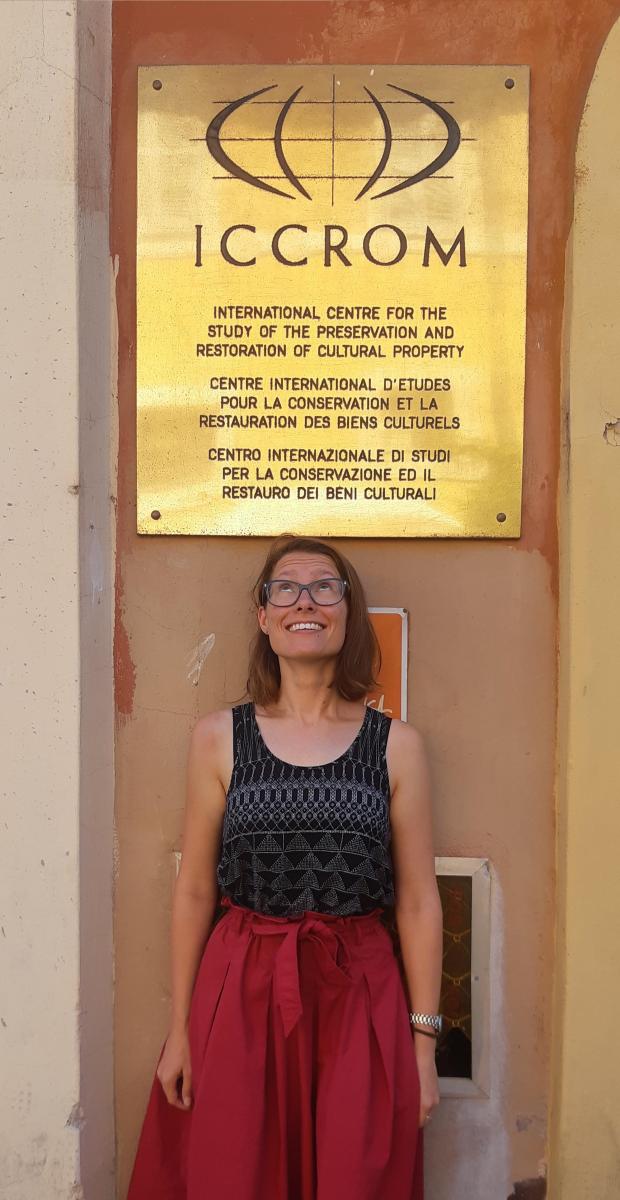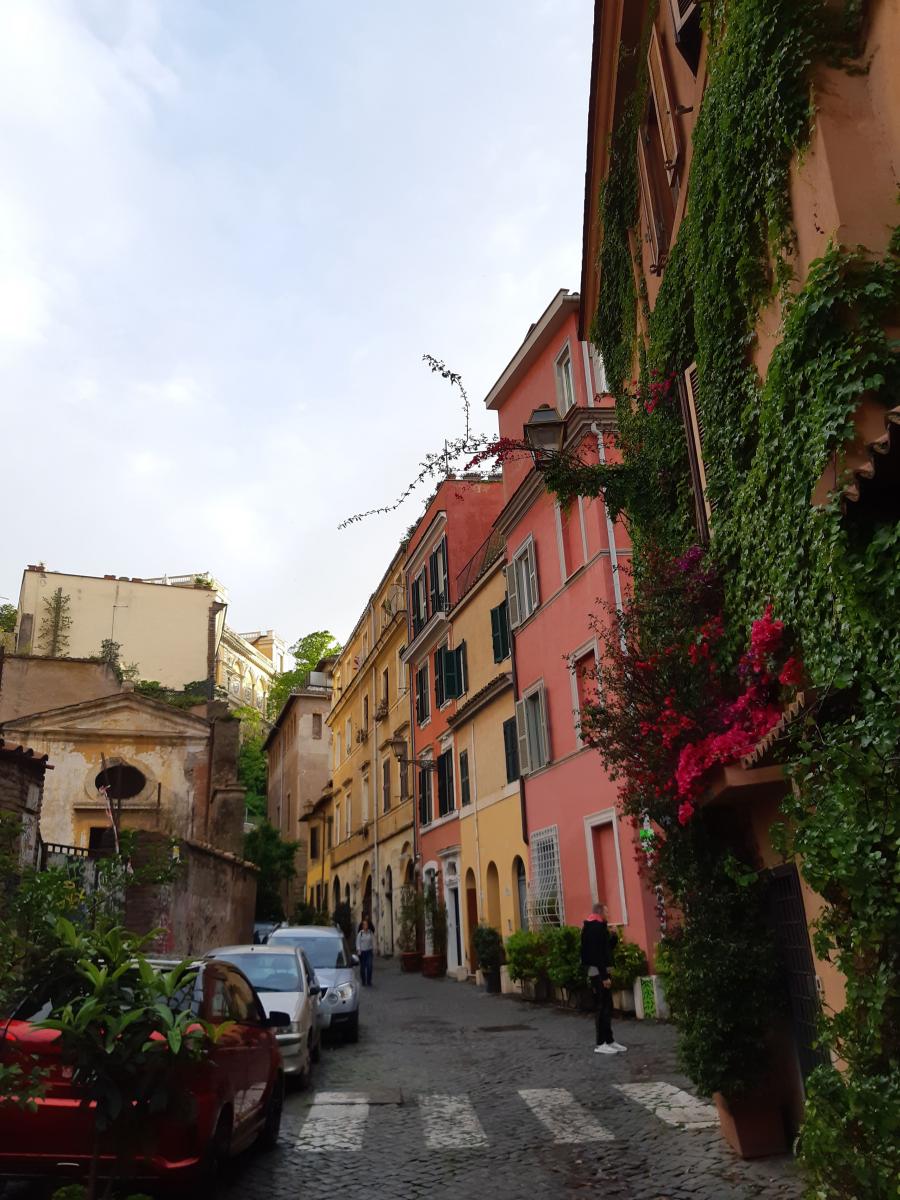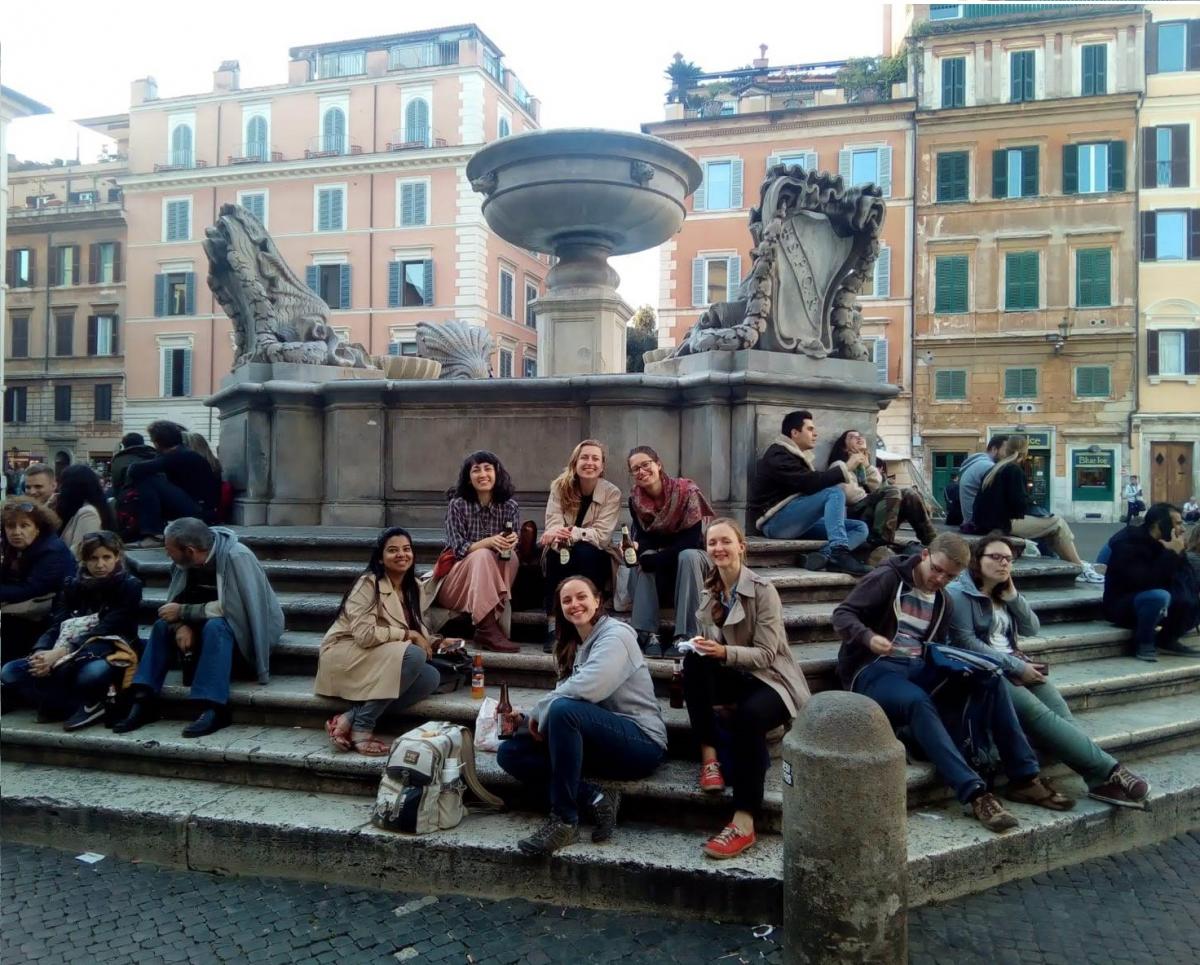In April 2019, I commenced a three-month internship at the International Centre for the Study of the Preservation and Restoration of Cultural Property (ICCROM) in Rome, Italy. ICCROM is an intergovernmental organisation that was founded in 1956 by UNESCO and established in Rome in 1959, in response to the widespread destruction of cultural property following WWII. The only institution of its kind, ICCROM has a worldwide mandate to promote the conservation of all moveable and immoveable cultural heritage. Working at international and governmental levels and with institutions and professionals on the ground, ICCROM employs an interdisciplinary approach that emphasises training, information, research, cooperation and advocacy. Australian conservators will probably be most familiar with ICCROM’s highly regarded publications (1) and training program offered around the world, often developed in response to current international challenges and based on the latest conservation research.

When applying for an internship at ICCROM, applicants are asked to select a priority area in which they would like to work. My particular interest lies in preventive conservation and conservation in Southeast Asia. I was selected to work on CollAsia, an ICCROM educational program that aims to empower heritage collection professionals who are conserving and using collections in Southeast Asia. This project was chosen on the basis of my experience working in Preservation and researching Southeast Asian Islamic manuscripts at State Library Victoria, a previous internship at the National Museum of the Philippines, and participation in the Asia Pacific Tropical Climate Conservation Art Research Network (APTCCARN).
CollAsia connects the specialist knowledge of living heritage traditions with scientific principles and conservation ethics. Courses explore locally available materials and techniques with the intention of developing viable, cost-effective, sustainable solutions, reduce dependence on imported materials and establish opportunities for collaboration with local industries. Applied research is encouraged to find local solutions to context-specific issues, as a means to move away from ‘ready-made’ or ‘one-size-fits-all’ conservation methods. Additionally, CollAsia promotes a people-centred, value-based approach to ensure that conservation activities engage with stakeholders in a meaningful way.
At ICCROM, I was supervised by José-Luiz Pedersoli Jnr, a Project Manager in the Collections Unit. My work focused on two main areas—developing the program and materials for the upcoming CollAsia course, ‘Planning new exhibitions: conservation, communication, community’(2); and investigating how we might integrate more sustainable practices into the organisation and content of the course.
Over 15 years, CollAsia has built up a strong regional network by training over 400 professionals from 46 countries. ‘Planning new exhibitions’ will be hosted by the Lao National Museum in Vientiane from 2 to 23 October 2019. The museum has relocated and staff are currently designing exhibits and looking for new ways to attract visitors. The course program was developed over several weeks in collaboration with fellow intern Tahmida Afroze, an architect and former CollAsia participant from Bangladesh. Further refinement was made based on feedback from the CollAsia teaching team—including exhibition designers, curators, education officers, collection managers and conservators—resulting in a final program that is comprehensive, if not a little ambitious!
Each day of the course will focus on a clear theme that is broken down into four discrete sessions, each with an activity and specific outcome. The first week is all about conceiving the idea of an exhibition—thinking about what it is about, who it is for, and how to document and tell a story with objects, and understanding value and significance. The second week is about planning an exhibition—considering the context (location, duration and purpose), budget, schedule and team, as well as managing risks to objects in their environment and factoring this into the design. The following week is about implementing an exhibition, with more practical activities around conservation, loans, packing, moving, installing and mounting objects, in addition to public programming and communication and activating heritage collections with contemporary makers and artists. The final focus is on monitoring exhibitions, planning and responding to disasters and interpreting data for evaluation and sustainability. Key to the program is the recognition that there is no one single way to plan and deliver an exhibition, and so there will be ample opportunity for participants to share their own experiences and to apply their learning on study visits.
CollAsia training is intentionally hands-on and practical to facilitate critical thinking, problem-solving and decision-making skills. It’s aimed at generating knowledge through active participation and not just passive listening and replication. To this end, I helped develop topics for group discussions, practical exercises and interactive group activities. The course materials I produced included work sheets, sample documents, a condition report template and glossary, word lists for translation, building plans and scale models, flash cards and case studies. Planning these activities was a good chance to reflect on my own learning to date. It was especially useful to refine the course program with Dinah Eastop and Flavia Parisi, both experienced conservation educators. They have a valuable perspective on what is effective in a classroom made up of different backgrounds and experience levels, and especially when not everyone speaks the same language.
As many of the proposed activities will involve objects, I worked with Dinah to select didactic objects from the CollAsia teaching collection. Stored at the ICCROM office in Rome, the collection has been carefully compiled over many years by Dinah and Katrina Similä, and it was thought-provoking to discuss the teaching potential of each object (3). For CollAsia 2019, we were careful to choose objects with more than one application. For example, objects with different material types, vulnerabilities and points of fragility; and objects that are not static, whether through suspension, movement, sound, touch, smell, illumination or time. Such objects are potentially challenging to display and the way they are exhibited will affect their meaning or interpretation.
Exhibitions can consume a huge amount of resources, and produce a lot of waste, in terms of energy, construction materials and transport. ‘Planning new exhibitions’ presents a chance to explore sustainability in practice. Sustainability is often defined as ‘meeting the needs of the present without comprising the ability of future generations to meet their own needs’ (4). For exhibitions, the definition pertaining to the sustainable consumption of resources is perhaps more useful—to reduce our environmental impact by minimising the amount of resources we consume and waste we produce (5).
To gather some ideas, I got in touch with Sustainability in Conservation (SiC) and was able to meet their founder, Caitlin Southwick (who was conveniently also in Rome undertaking her own internship at the Vatican Museums). In June 2019, SiC launched a Sustainability Toolkit (6) designed to help organisations implement sustainability initiatives. I adapted this model to create a CollAsia activity that will introduce the idea of sustainable consumption, encourage participants to identify areas for improvement in exhibitions and then guide them through a series of questions to develop a solution for a specific problem.
A major goal for CollAsia 2019 is to eliminate or at least greatly reduce the amount of waste produced during the course—to go ‘zero waste’. The priority will be to eliminate or reduce any waste and to recycle, compost or reuse as much as possible, to minimise the amount of waste sent to landfill. The aim is to lead by example and encourage everyone involved to make carefully informed, sustainable choices. It will require good communication, collaboration and commitment from the organisers, teaching team, participants, museum staff, caterers and suppliers. I created a checklist to guide the planning of different aspects of the event (such as the venue, course materials, catering and transport) as well as a template to measure and evaluate outcomes of the initiative. While the suggestions will not suit every situation, they should provide a starting point and hopefully generate more ideas (7).

Beyond the opportunity to work on CollAsia, was the chance to be involved with the various activities happening across the other units at ICCROM. I was a keen observer and contributor in planning meetings for other upcoming ICCROM programs, including First Aid to Cultural Heritage, RE-ORG, and a textile conservation course. Regular Friday lunchtime lectures and discussions were held with visiting scholars on a range of topics, including Dr Erin Seekamp (heritage significance assessment and sustainability in an era of climate change), Dr Ania Kortaba-Morley (archaeology in Kiribati), José de Nordenflycht-Concha (Latin American heritage) and Professor Mauro La Russa (underwater archaeology). A special highlight was a six-hour walking tour of Rome, led by the incomparable Gaël de Guichen—a conservator with almost mythical presence, who has been a stalwart figure at ICCROM since the late 1950s, when he was mentored by its first Director, Dr Harold James Plenderleith.
Another big draw to ICCROM was the prospect of spending uninterrupted time in its library, with its extensive catalogue of resources related to all aspects of cultural heritage. It is one of the most important conservation libraries in the world, particularly for older publications that are no longer in print, and publications in languages other than English. The catalogue is searchable online and photocopying and document delivery is provided (at cost) to anyone, for publications that are not digitally available (8). Archivist Maria Mata Caravaca also provided a tour of the ICCROM archives, which contain almost 60 years of records of training and preservation projects, including photographs, documents and AV materials. The archives also contain material samples of wall paintings, mosaics and textiles, as well as important records of sites and monuments around the world, some no longer in existence because of conflict or natural disasters.
Perhaps the most memorable and motivating aspect of the whole experience was the camaraderie and collaboration within the intern group—nine of us in total, from Italy, France, the Netherlands, Brazil, Bangladesh, Australia and the United States. While we all came from different educational and professional backgrounds—including archives, art history, collection management, law, emergency response, contemporary art, museum studies, architecture and conservation—it was stimulating to work within such a diverse group, with a shared enthusiasm for preserving cultural heritage and finding the best Friday night aperitivo.

ICCROM is a small organisation, but mighty in its scope and reach. It is a truly international operation with dedicated staff from all over the world and ongoing projects covering Asia, the Middle East, Latin America and Africa. The opportunity to learn from diverse professionals with varied perspectives, on wide-ranging and ambitious projects, made for an enriching and exciting work environment. While I will miss being able to (just) see Roman ruins from my office window, I’m eager to return to State Library Victoria to share, discuss and apply some of these new ideas with my colleagues.

I would like to thank ICCROM and the Collections Unit for facilitating the internship and my colleagues at State Library Victoria for their encouragement and enabling the time for me to participate. I am deeply grateful to the Gordon Darling Foundation, for providing a Darling Travel Grant, which allowed me to take up such a wonderful opportunity.

References & links:
(1) ICCROM Publications, <https://www.iccrom.org/resources/publications>.
(2) ICCROM 2019, CollAsia Course announcement, <https://www.iccrom.org/courses/planning-new-exhibitions-conservation-communication-community>.
(3) Similä, K & Eastop, D 2017, ‘Celebrating different points of view’, in J. Bridgland (ed.), ICOM-CC 18th Triennial Conference Preprints, 4–8 September, Copenhagen, International Council of Museums: Paris.
(4) Brundtland, G 1987, Report of the Word Commission on Environment and Development: Our Common Future, United Nations General Assembly document, <https://sustainabledevelopment.un.org/content/documents/5987our-common-future.pdf>.
(5) Ofstad, S, Westly, L & Bratelli, T 1994, Symposium: sustainable consumption 19–20 January, Oslo, Norway, Ministry of Environment: Norway.
(6) Sustainability in Conservation 2019, Sustainability Toolkit, <https://www.sustainabilityinconservation.com/sustainability-toolkit>.
(7) Keppel, E 2019, ‘Going Zero Waste: promoting sustainable consumption and production in cultural heritage training’, <https://www.iccrom.org/projects/going-zero-waste-promoting-sustainable-consumption-and-production-cultural-heritage>.
(8) ICCROM Library catalogue, <https://www.iccrom.org/resources/library-services>.